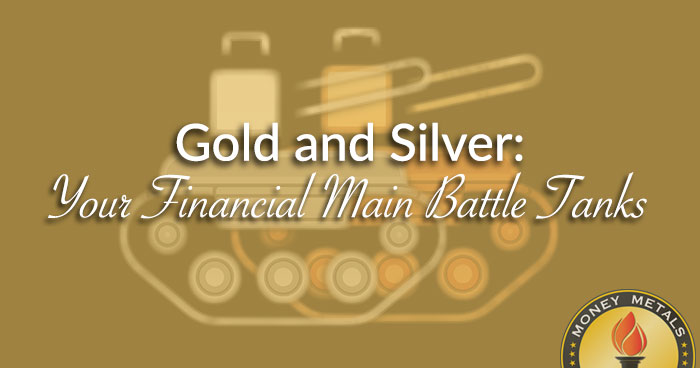Armored vehicle-enabled soldiers and the designers who build them understand that a main battle tank must balance three critical elements to "complete the mission."
This has been true conceptually since the time of David and Goliath, the Three Hundred Spartans at Thermopylae, with Alexander the Great's elite Silver Shields, and tank battles in four Israeli wars.
As an analogy for those who acquire and hold precious metals, it offers a close fit to their ability to "complete the financial mission" of asset protection and growth.
First, a main battle tank must have superior firepower, being able to reliably counter and defeat its adversaries on the field of battle.
Second, the armored vehicle must offer protection for the crew. Otherwise, the battlefield gets swept clean by "the opposition," and, as casualties mount, survivors' morale plummets, and the battle is lost.
Third, to survive multiple engagements, a tank must be highly mobile to stay out of harm's way, reposition to counter the enemy's armor, and dispose of its tactical weaponry.
When David fought Goliath, he lacked protection (a shield) and "firepower" (a sword or spear). But he was able to override these deficiencies through superior mobility, skill with a slingshot... and tactics.
Yes, well-thought-out and executed tactics can sometimes defeat an opponent who outclasses you in all three respects, but that's not the way to bet, nor, as an investor, should you have to.
Proper planning, patience, and execution with precious metals add a decisive safety factor with less correlation to other asset holdings.
Since the invention of the modern tank near the end of WWI, the three imperatives listed above have been manipulated in an attempt to gain a battlefield advantage without throwing the trifecta out of reasonable balance.
In WWII on the Eastern Front against the Russians, consider the German Jagdtiger ("Hunting Tiger").
This massive beast, the heaviest armored vehicle used by any nation in the war, could defeat all comers. But it was so heavy, it could not cross most bridges, had an underpowered drive train, and was plagued with mechanical problems.
On the other hand, the Russians fielded the T-34. This tank was smaller and less armored but was reliable, highly mobile, and could be produced in massive numbers.
When attacking in formation a member of the Tiger tank family, it could sometimes damage its tracks. The now immobilized giant could be finished off with heavy artillery or explosive charges.
Balancing these elements is always a struggle for the designer. Placing too much emphasis on any one factor inevitably compromises – or defeats – the mission and those tasked with carrying it out.
How does the main battle tank analogy relate to holding precious metals?
Firepower. Look back at silver and gold prices since 2001. Silver began at about $4.50/ounce. Today, even at the recent reaction low, it's $22.00, plus a healthy premium of $3-$6, spot price.
At the same time, physical gold cost $270, with a modest premium. Today an ounce will set you back about $1,780, along with a 5% premium.
After over a year of sideways action from the August 2020 spike high above $2,000, gold's asset protection profile still eclipses by double that of the more widely watched S&P 500 measured over the same two decades.
Protection. Silver and gold protect (hedge) your other assets because they effectively limit the erosion of their value by inflation.
These days, this factor is even more important for near-cash savings accounts, with their tiny interest yield of less than one-half of one percent per annum! And sticking with bullion coins/bars builds simplicity and minimizes premium cost.
Mobility. Unlike most any other asset class, precious metals can be turned into cash at a moment's notice.
Indeed, the reason metals' prices so often decline (temporarily) during periodic crashes like 2008 and early 2020, is that they are easily sold by heavily margined or over-positioned traders, to raise liquidity or limit losses in other sectors.
Hold-in-hand metal – from a liability of loss standpoint – has no one standing between you and the buyer from whom you redeem it for cash. Evergrande bond and stockholders, eat your hearts out!
Given these implications, would you rather enter the battlefield with physical gold and silver -encased in a metaphorical Abrams M-1, Israeli Merkava, or German Leopard tank – or "armed" only with a sheet of paper showing you have unallocated (mixed with others' holdings) metal in an untested storage facility? Or even worse, in a non-redeemable ETF?
And don't just say "Well I'll play it safe by holding stocks or bonds, and hope for the best!" Because of the way things are shaping up, it's more than likely that soon you may seriously regret doing so.
So either ford the stream of indecision now before the "runoff" gets too strong. Or wait until the inflationary flow is so powerful that you must attempt to act – even if it turns out to be impossible, and the real value of your assets is swept away in the process?
Renowned commodities trader Dr. Alexander Elder's battlefield quote perfectly sums up the investor's dilemma, as well as the path to investment survival and success. He says it consists of "battling crowds of hostile people while paying for the privilege of entering the battle and leaving it whether dead, wounded, or alive."
These days, whether we like it or not, we're ALL on an investment battlefield.
For the foreseeable future, as the financial system wends its way through uncharted waters, place the odds measurably in your favor by holding gold and silver – the historic talismans of asset protection.

About the Author:
David H. Smith is the Senior Analyst for TheMorganReport.com, a regular contributor to MoneyMetals.com as well as the LODE digital Gold and Silver Project. He has investigated precious metals mines and exploration sites in Argentina, Chile, Peru, Mexico, Bolivia, China, Canada, and the U.S. He shares resource sector observations with readers, the media, and North American investment conference attendees.





